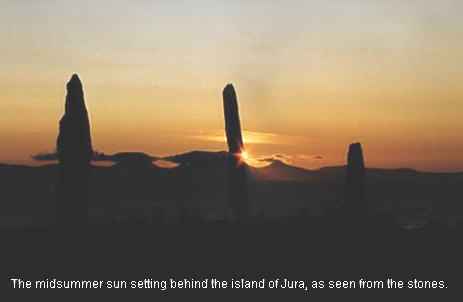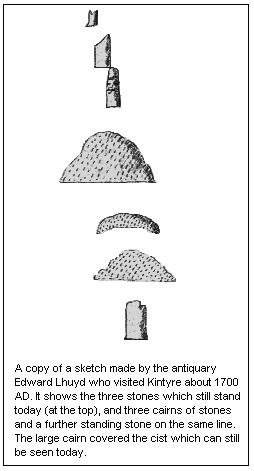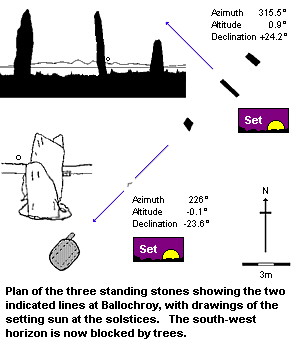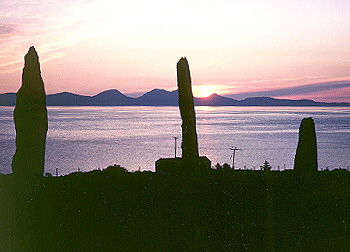
Ballochroy, Kintyre
Stones
of Wonder
QUICK LINKS ...
HOME PAGE
INTRODUCTION
WATCHING
THE SUN, MOON AND STARS
THE
MONUMENTS
THE
PEOPLE AND THE SKY
BACKGROUND
ARCHAEOASTRONOMY
USING
THE SITE DESCRIPTION PAGES
VISITING
THE SITES
THE
LEY LINE MYSTERY
THE
SITES
ARGYLL
AND ARRAN
MID
AND SOUTH SCOTLAND
NORTH
AND NORTH-EAST SCOTLAND
WESTERN
ISLES AND MULL
Data
DATES
OF EQUINOXES AND SOLSTICES, 1997 to 2030 AD
DATES
OF MIDSUMMER AND MIDWINTER FULL MOONS, 1997 to 2030 AD
POSTSCRIPT
Individual
Site References
Bibliography
Links
to other relevant pages
Contact
me at : rpollock456@gmail.com
Standing stones and kist NR 730525*
How to find : On the A83, 18km south of Tarbert.
The site is not visible from the road. A track which you can walk up leads off the main road at NR726527 and climbs the hill to a large barn. The stones are visible in the field beside the barn.
Leave your dog in the car. Please leave all gates as you find them.
Best time of year to visit : Summer solstice around the 21st of June.
The alignment also indicates the setting sun at the winter solstice, but the horizon in that direction is now hidden by trees. However the sunset can still be observed.
Warning : Midges are exceptionally numerous in Kintyre, and the summer solstice is the height of their season. Be prepared! Otherwise your visit will be ruined!

 This
is an impressive and distinctive site. The three standing stones at Ballochroy
have been claimed as a convincing prehistoric observatory, capable of
determining the actual day of the solstice.
This
is an impressive and distinctive site. The three standing stones at Ballochroy
have been claimed as a convincing prehistoric observatory, capable of
determining the actual day of the solstice.
They are the most spectacular of a set of megalithic monuments which cluster around south Argyll. The site consists of a line of three mica schist stones, 3.5m, 3.0m and 2.0m in height. The line of stones is orientated north-east to south-west. The smallest stone has possibly been broken off at the top.
The site was first scientifically surveyed by Alexander Thom, who demonstrated that the stone alignment to the southwest indicates the setting position of the sun over the west end of Cara island at midwinter, about 1800 BC. The view to Cara island from the stones is presently obscured by a plantation and the drawing shows the view to the close southwest horizon.
A Bronze age cist lies 35m away to the south-west, which a drawing made around 1700AD shows to be covered at that time by a huge cairn of stones. It has been pointed out that this would have blocked the view to Cara Island. However, there is no proof of how high the cairn actually was and the kist itself is exactly on the axis of the south-westerly alignment, which surely confirms the importance of the line to the builders. The same drawing also shows a further two smaller cairns and another standing stone on the same alignment.
The flat face of the central stone (at right angles to the alignment) indicates the mountain of Cora Bheinn, on the island of Jura, which is 30 km away. This mountain is one of the range called the Paps of Jura. In prehistoric times the sun would have flashed out on the right hand slope of Cora Bheinn as it set on midsummer's day. Today the setting position of the sun at midsummer is to the south of this, and one sees the sun set in the col between Beinn Shiantaidh and Cora Bheinn. It is still an inspiring sight.
Be warned though, because of the distance of the island of Jura across the sea it is not always visible, and in any but the best weather you may not see Jura clearly. The author lived in Kintyre for two years and seldom saw the Paps free of cloud cover, even when the rest of the horizon was clear. So take your chance to visit on any clear day in June close to midsummer.
The shortest stone also faces across the alignment, and points to Ben a'Chaolais, the southernmost of the four Paps of Jura. The sun setting here would have given warning of the approach of the solstice.


Midsummer sunset at Ballochroy
Return to Argyll index